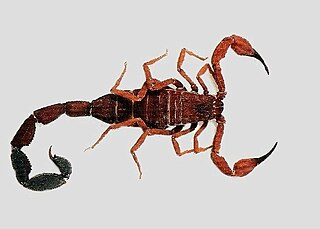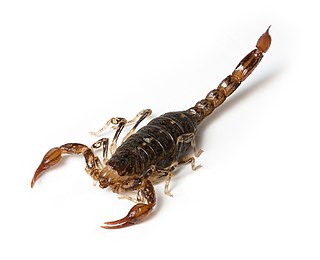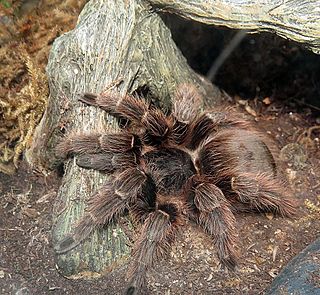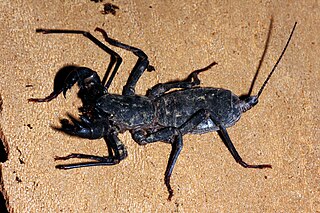
Lycosa is a genus of wolf spiders distributed throughout most of the world. Sometimes called the "true tarantula", though not closely related to the spiders most commonly called tarantulas today, Lycosa spp. can be distinguished from common wolf spiders by their relatively large size. This genus includes the European Lycosa tarantula, which was once associated with tarantism, a dubious affliction whose symptoms included shaking, cold sweats, and a high fever, asserted to be curable only by the traditional tarantella dance. No scientific substantiation of that myth is known; the venom of Lycosa spiders is generally not harmful.

Diplura is a genus of South American curtain web spiders that was first described by C. L. Koch in 1850. It is found in South America and Cuba belonging to the subfamily Diplurinae.

The Sclerosomatidae are a family of harvestmen with about 1,300 known species. One former subfamily has been recently removed to form a new family, Globipedidae.
Kimulidae is a small neotropical family of the harvestman infraorder Grassatores with about thirty described species.

Mastigoproctus is a genus of whip scorpions. Native to the tropical forest regions of northern South America, these whip scorpions can reach a length of up to 9 centimetres (3.5 in) and can weigh over 30 grams (1.1 oz). Despite popular belief, they are not venomous as, like all other whip scorpions, they do not possess venom glands.

Tityus is a large genus of thick-tailed scorpions, the namesake of its subfamily Tityinae. As of 2021, Tityus contains more than 220 described species distributed in Central America and South America, from Costa Rica to Argentina. Species in the genus Tityus have been studied for hundreds of years, long before the taxonomic classification was put in place. Tityus tend to be of medium size for scorpions, roughly 50 to 70 millimeters long. They are dark brown or red in color, and can exhibit sexual dimorphism. They can live in a variety of environments, ranging from urban to arid mountains to the Amazon Rainforest. Tityus scorpions are best known for their venom and potent sting. The genus contains several dangerously venomous scorpions, the best known of which is the Brazilian yellow scorpion, T. serrulatus. Its venom can cause severe illness, and in the young, old and infirm even death. Some experts have argued that the genus as a whole may be paraphyletic, which could explain the knowledge gaps related to Tityus.
Paratamboicus was a genus of harvestmen in the family Sclerosomatidae from the Americas, described by Mello-Leitão 1940 with the type-species by original designation being Paratamboicus bicornutus Mello-Leitão, 1940. It was much later considered as Junior subjective synonym of Holcobunus Roewer 1910 by Tourinho & Kury (2001).

The Bothriuridae are a family of scorpions, comprising 151 species in 16 genera.

Opisthacanthus is a genus of scorpions in the family Hormuridae occurring in Central and South America, the Caribbean, Africa and Madagascar.

Phrynus is a genus of whip spiders found in tropical and subtropical regions, mostly in the new world.

Eupalaestrus is a genus of South American tarantulas that was first described by Reginald Innes Pocock in 1901.

Bothriurus is a genus of Neotropical scorpions in the family Bothriuridae. They occur in many different habitats in South America, including deserts, steppes, savannas and forests.

Typopeltis is an Asian genus of whip scorpions or 'vinegaroons' and currently the only member of subfamily Typopeltinae.

Thelyphonellus is a genus of Thelyphonid whip scorpions, first described by Reginald Innes Pocock in 1894.

Charinus is a genus of amblypygids (whip-spiders) of the family Charinidae.














